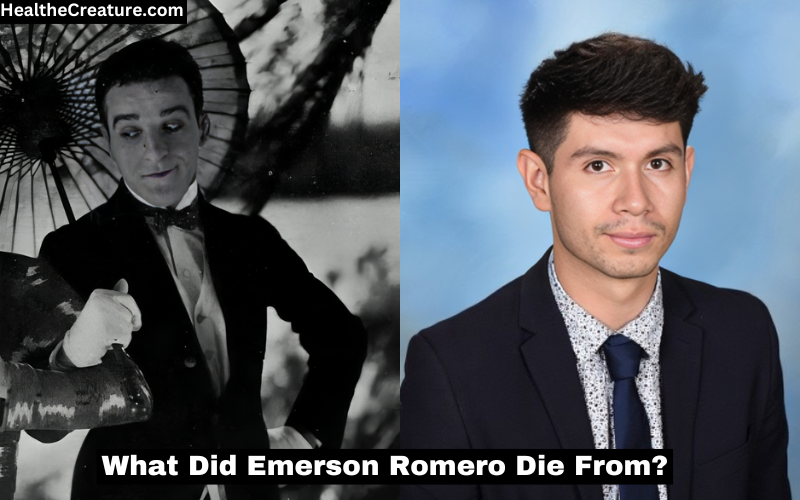Emerson Romero, a trailblazing Cuban-American silent film actor and advocate for the deaf community, passed away on October 16, 1972, in Boulder, Colorado. Many have wondered, What did Emerson Romero die from? While the specific cause of his death is not publicly documented, his legacy and impact remain deeply rooted in the history of film accessibility. Romero’s life journey, from a silent film actor to an innovator in making films accessible to the deaf and hard-of-hearing community, highlights his resilience and creativity.
Despite facing numerous challenges, particularly during the transition from silent to sound films, Romero continued to champion accessibility and inclusivity. His contributions to film captioning laid the foundation for modern closed captioning, making him a significant figure in media history.
Who is Emerson Romero?
Emerson Romero was a Cuban-American actor, filmmaker, and advocate for the deaf community. Born on August 19, 1900, in Havana, Cuba, Romero lost his hearing at the age of six due to complications from whooping cough. This profound life event shaped his career and personal mission to promote inclusivity. He began his acting career in Cuba’s silent film industry, using the stage name Tommy Albert. However, with the advent of sound films, Romero shifted his focus toward advocating for accessibility in media.
He became a pioneer in film captioning, developing early techniques to make movies accessible to deaf audiences. Beyond his professional achievements, Romero was a devoted family man, married to Emma “Connie” Corneliussen, with whom he had two accomplished children. His life and work remain a testament to overcoming adversity and breaking barriers for marginalized communities.
Cause of Death
The question, What did Emerson Romero die from?, remains unanswered as the exact cause of his death has not been publicly disclosed. However, his passing marked the end of a life dedicated to advocacy and innovation. Born in 1900 in Havana, Cuba, Romero faced adversity from an early age, losing his hearing at six due to complications from whooping cough. This profound life event shaped his future, inspiring him to create pathways for the deaf community to engage with art and culture.
While his death might not be attributed to a widely known illness or condition, the lack of detailed records about his health suggests that he lived his later years in relative privacy. His contributions, however, continue to echo in the fields of accessibility and media inclusivity, making his life’s work far more significant than the circumstances of his passing.
Quick Facts About Emerson Romero’s Death
| Date of Death | October 16, 1972 |
| Place of Death | Boulder, Colorado |
| Cause of Death | Not publicly disclosed |
| Legacy | Pioneer in film accessibility |
Place of Death
Understanding what did Emerson Romero die from? also involves considering where he spent his final days. Emerson Romero passed away in Boulder, Colorado, a place where he had chosen to retire and spend his later years. Boulder’s serene environment provided a perfect setting for Romero to reflect on his life’s achievements and enjoy time with his family. His children, Rod and Dorene, were both accomplished academics, and living close to them allowed Romero to remain connected to his loved ones.
Boulder’s reputation as a peaceful and inclusive city might have resonated with Romero’s lifelong commitment to creating accessible spaces for marginalized communities. While the exact details surrounding his final days remain sparse, his choice of Boulder as his home underscores his desire for a calm and family-centered life in his twilight years.
Early Life and Education
To understand what did Emerson Romero die from?, it’s important to explore his early life and the challenges he faced. Emerson Romero was born on August 19, 1900, in Havana, Cuba. At the age of six, he lost his hearing due to complications from whooping cough, a life-changing event that shaped his future endeavors. Despite his hearing loss, Romero’s family ensured he received a comprehensive education. He attended the Wright Oral School in New York City, where he learned lip reading and speech.
Later, he continued his studies at Stuyvesant High School, Interlaken High School, and Blair Academy. His academic journey culminated in a brief stint at Columbia University before transferring to Lafayette College in Pennsylvania. Financial difficulties, however, forced him to leave after two years. These formative years showcased Romero’s determination to overcome barriers, setting the stage for his later contributions to accessibility and inclusivity in the arts.
Acting Career
Romero’s acting career is another crucial aspect to consider when reflecting on what did Emerson Romero die from?. His foray into acting began in 1924 when he joined his brother’s film company, the Pan-American Film Corporation, in Cuba. Using the stage name Tommy Albert, he starred in over 20 short films during the silent film era. His notable works included films like “Great Guns” and “The Cat’s Meow,” which showcased his talent and charisma.
However, the advent of sound films in 1927 significantly limited opportunities for deaf actors, prompting Romero to return to New York. Undeterred, he co-founded the Theatre Guild of the Deaf in 1934, an initiative aimed at promoting deaf talent in the performing arts. Through his acting career, Romero not only entertained audiences but also broke stereotypes, proving that deaf individuals could excel in creative fields.
Innovations in Film Accessibility
One of Romero’s most enduring contributions was his pioneering work in film captioning, which is essential to his legacy and helps contextualize what did Emerson Romero die from?. In 1947, he developed a technique for adding captions to sound films by inserting text frames between film strips. This innovation made movies accessible to deaf and hard-of-hearing audiences, addressing a significant gap in media inclusivity.
Although his method was rudimentary compared to today’s closed captioning systems, it laid the groundwork for future advancements. Romero’s efforts inspired the development of government-funded programs like Captioned Films for the Deaf, which standardized and expanded captioning practices. His work not only transformed how films were consumed by the deaf community but also underscored the importance of accessibility in all forms of media.
Personal Life
Romero’s personal life also provides insight when exploring what did Emerson Romero die from?. In 1936, Romero married Emma “Connie” Corneliussen, a graduate of the Minnesota School for the Deaf and Gallaudet College. The couple had two children, Rod and Dorene, both of whom pursued distinguished academic careers. Rod earned a master’s degree in electrical engineering from the Massachusetts Institute of Technology, while Dorene graduated from the Sorbonne in Paris.
Romero’s family life was marked by mutual support and a shared commitment to education and personal growth. His wife’s background in deaf education complemented his advocacy efforts, making them a formidable team in promoting accessibility. In his later years, Romero cherished his role as a father and grandfather, finding joy in the accomplishments of his children and their families.
Legacy
The question what did Emerson Romero die from? may not have a clear answer, but his legacy transcends the details of his passing. Emerson Romero’s legacy is one of resilience, innovation, and advocacy. His pioneering efforts in film accessibility have had a lasting impact, inspiring subsequent advancements in media inclusivity. Modern closed captioning systems owe a debt to Romero’s early innovations, which demonstrated the feasibility and importance of making films accessible to all.
In recognition of his contributions, the New York City Civic Association of the Deaf honored him with its annual civic achievement award in 1970. Romero’s life serves as a testament to the power of determination and creativity in overcoming barriers. His work continues to inspire efforts toward inclusivity in the arts and beyond, ensuring that his legacy endures for generations to come.
See Also: How Did Franklin D. Roosevelt Die?
FAQs
Who was Emerson Romero?
Emerson Romero was a Cuban-American silent film actor and advocate for the deaf community. He is best known for his pioneering work in making films accessible to deaf and hard-of-hearing audiences through early captioning techniques.
What did Emerson Romero die from?
The specific cause of Emerson Romero’s death has not been publicly disclosed. He passed away on October 16, 1972, in Boulder, Colorado.
What was Emerson Romero’s contribution to accessibility?
Romero developed an early technique for captioning sound films by inserting text frames between film strips. This innovation laid the foundation for modern closed captioning systems.
Where was Emerson Romero born?
Emerson Romero was born in Havana, Cuba, on August 19, 1900.
What challenges did Emerson Romero face as a deaf actor?
Romero faced significant challenges with the advent of sound films in 1927, which limited opportunities for deaf actors. He responded by becoming an advocate for accessibility and co-founding the Theatre Guild of the Deaf.
What is Emerson Romero’s legacy?
His legacy lies in his contributions to film accessibility, particularly his early work in captioning. His efforts have inspired advancements in media inclusivity and accessibility.
Did Emerson Romero have a family?
Yes, Romero was married to Emma “Connie” Corneliussen, and they had two children, Rod and Dorene, who both pursued successful academic careers.
Conclusion
Emerson Romero’s life is a story of perseverance, innovation, and advocacy. From overcoming the challenges of losing his hearing as a child to pioneering accessibility in the film industry, Romero demonstrated unwavering commitment to inclusivity. His early efforts in captioning sound films not only opened up new avenues for the deaf community but also set the stage for modern closed captioning technologies.
Though the question what did Emerson Romero die from? remains unanswered, his contributions to accessibility and advocacy have left an indelible mark. Romero’s work continues to inspire efforts toward creating a more inclusive world, ensuring that his legacy endures for future generations.


